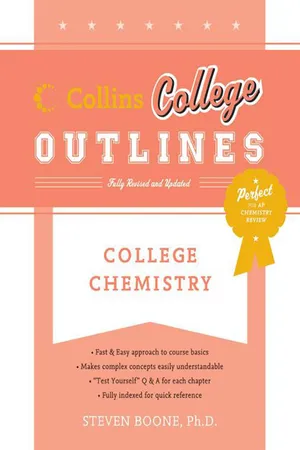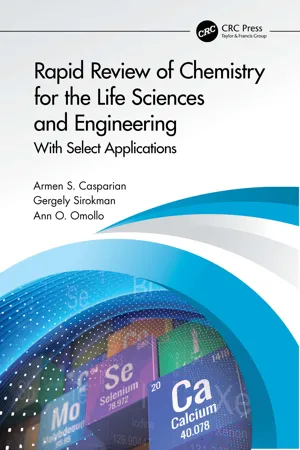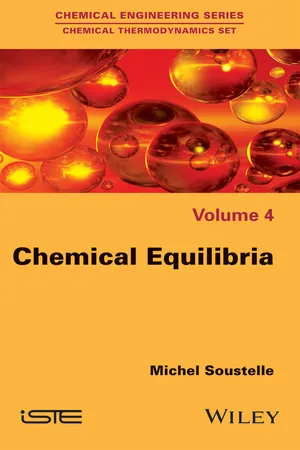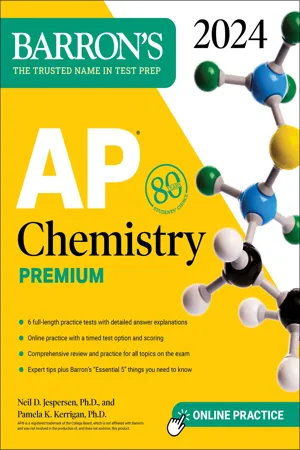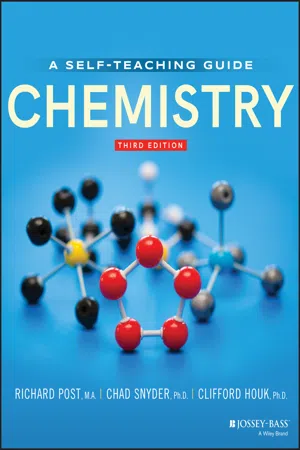Chemistry
Representations of Equilibrium
In chemistry, representations of equilibrium refer to visual or symbolic depictions of the balanced state reached in a reversible chemical reaction. These representations often include chemical equations, graphs, and diagrams to illustrate the dynamic nature of equilibrium, where the rates of the forward and reverse reactions are equal. They help in understanding the relationship between reactants and products at equilibrium.
Written by Perlego with AI-assistance
Related key terms
Related key terms
1 of 4
Related key terms
1 of 3
8 Key excerpts on "Representations of Equilibrium"
- Stella Vosniadou, Erik De Corte, Robert Glaser, Heinz Mandl(Authors)
- 2012(Publication Date)
- Routledge(Publisher)
4M:Chem. In this section, we describe the system and show how it implements the multiple, linked representation approach to learning chemical equilibrium. In the subsequent section, we examine preliminary evidence that supports the effectiveness of this approach.The environment currently includes four chemical systems: a physical equilibrium, a gas-phase equilibrium, a solution equilibrium, and a heterogeneous equilibrium. These are structured progressively so that students can move from a simple mental model of equilibrium to a more elaborate, complex understanding of the concept (White, 1993).Development on the system continues, but we estimate that in its current form it would take up to 8 hours in lecture and another 5–6 hours in laboratory sessions to thoroughly explore the completed portions. It is designed both for use with projection equipment in the lecture hall and individual work stations in classroom laboratories. In lecture, it is designed to make the class more interactive and engaging. In the classroom laboratory, it allows students, working individually or in small groups, to conduct structured, in-depth investigations of chemical phenomena.FIG. 3.1. Screen display of 4M:Chem showing multiple, linked representations (original in color).The symbol systems or representations that we use include: chemical notation, video of the reactions, molecular-level animations, dynamic graphs, displays of absorption spectra, and tabular data (see Fig. 3.1 for a sample screen display). The software allows learners to act on a chemical system and see the results of these actions propagate across the multiple representations. Let us examine how the use of these representations, individually and together, might act to influence understanding.Symbolic Elements and EventsThere is an operational space we present on the screen called the control window. It contains one representation of the chemical system that students have selected from a menu of available systems; it is expressed in the standard notation of chemists:The equation expresses a relationship between two symbolic entities. The entities and their relationship are, perhaps, yet to be understood by the students. The buttons present the students with two symbolic actions that can be performed on the system: “heat” or “cool.” These symbolic elements and buttons are what we term the literal features- No longer available |Learn more
- Steven Boone, Drew H. Wolfe(Authors)
- 2011(Publication Date)
- Collins Reference(Publisher)
CHAPTER 15Introduction to Chemical Equilibria
Chemical equilibrium systems are more resistant to change than those that are not in equilibrium. When an equilibrium system is disturbed, it responds in order to reestablish a state of equilibrium.15.1 THE EQUILIBRIUM STATEChemical reactions proceed spontaneously until they reach a state of dynamic equilibrium. At equilibrium, the rate of the forward reaction equals the rate of the reverse reaction. At this point, the reactant and product concentrations remain constant.Forward and Reverse ReactionsArrows that point in opposite directions, , show that an equilibrium has established. For example, the following equation is written for the equilibrium of H2 and CO2 with CO and H2 O.H2 (g) + CO2 (g) CO(g) + H2 O(g)The reaction that goes from left to right is the forward reaction, and the reaction that goes from right to left is the reverse reaction. Establishing Equilibrium Consider the following model reaction as it establishes equilibrium.H2 (g) + CO2 (g) → CO(g) + H2 O(g)When H2 and CO2 mix at constant temperature in a reaction vessel, they combine and begin to form the products, CO and H2 O. Hence, the concentrations of H2 and CO2 decrease, and the concentrations of CO and H2 O increase. As the reactant concentrations decrease, the rate of the forward reaction decreases and the rate of the reverse reaction increases. At some point, the rate of the forward reaction equals the rate of the reverse reaction and a chemical equilibrium establishes. After this time, the concentrations of the reactants and products do not change.The Equilibrium Constant ExpressionAn important quantitative relationship exists between the concentrations of the reactants and products. This relationship was identified by Cato Maxmilian Guldberg and Peter Waage in 1864 when they proposed the Law of Mass Action that expresses the equilibrium concentrations of the reactants and products in terms of an equilibrium constant expression (equilibrium expression - eBook - ePub
Rapid Review of Chemistry for the Life Sciences and Engineering
With Select Applications
- Armen S. Casparian, Gergely Sirokman, Ann Omollo(Authors)
- 2021(Publication Date)
- CRC Press(Publisher)
4 Chemical EquilibriumDOI: 10.1201/9781003092759-44.1 Basic Concept
Reaction equations describe substances, called reactants, which when put together react and produce other different substances, called products. It may appear as if only products remain after the reaction is finished. In reality, many reactions do not go to completion, even if the reactants are present in stoichiometric ratios or amounts. Rather, they reach a condition known as equilibrium, denoted by double, reversible arrows in the reaction equation. Equilibrium means that there is a balance between the reactant side and the product side, or simply between the reactants and the products, and that the reaction is reversible. The chemistry of many air pollutants falls and many bodily functions under the heading of equilibrium reactions. The equilibrium condition is dynamic, not static, allowing microscopic changes in reactant and product concentrations to take place, such that no net change in reactant or product concentrations occurs, provided that no external stresses are applied. At any given time, all species in the reaction equation—reactants and products—are present at equilibrium in varying amounts. The relationship among these varying amounts can be described by a mathematical formula known as the equilibrium constant expression or simply the equilibrium expression. The equilibrium expression is set equal to an equilibrium constant symbolized by Kc .An equilibrium reaction can be generally represented as follows:a A + b B ⇋ g G + h H(4.1)The Kc expression can then be expressed as follows:(4.2)K c=[ G ]g[ H ]h[ A ]a[ B ]bwhere a, b, g, and h represent the stoichiometric coefficients in the balanced reaction, and the brackets [ ] indicate molar concentrations. The simplest interpretation of Kc is that it is a measure of the extent to which a reaction goes toward completion, i.e., a reaction where the product side is favored. The meaning of Kc - eBook - ePub
- Michel Soustelle(Author)
- 2015(Publication Date)
- Wiley-ISTE(Publisher)
3.3. Representation of the evolution of an equilibrium with the temperature
As temperature is an important variable of chemical equilibrium, users have attempted to represent the evolution of a chemical equilibrium with changing temperature. Two methods are discussed below.3.3.1. Diagram in van ’t Hoff coordinates
The first mode of representation is based on relation [3.28 ], applied in convention (I). The method involves representing, in standard pressure conditions (in practice at the pressure of 1 bar), the logarithm of the equilibrium constant as a function of the inverse of temperature. This representation gives us practically a straight line, because the standard enthalpy Δr h0 and standard entropy Δr s0 of the reaction are practically independent of the temperature. Hence, the slope of that line may be −Δr h0 / R, and its ordinate at the origin may be Δr s0 / R by virtue of relation [3.28 ].Representation of the evolution of an equilibrium with temperature as a van ’t Hoff diagramFigure 3.5.Figure 3.5 shows such a line in the case of an endothermic reaction (positive reaction enthalpy).3.3.2. Ellingham diagrams
The second mode of representation of the evolution of an equilibrium with the temperature is the generalized Ellingham diagram, which we shall now examine in detail.3.3.2.1. Ellingham representation
Consider the context of the pure-substance reference (I). The principle of that diagram is, at standard pressure, to plot the standard Gibbs energy Δr g0 for the reaction in the plane [T, RT lnQ(I) ] (Figure 3.6(a) ). Using relation [3.44 ], we can see that if the standard enthalpy Δr h0 and standard entropy Δr s0 of the reaction are practically independent of temperature (these are the so-called Ellingham approximations), the representative curve is a segment of straight line whose slope is the opposite of the standard entropy Δr s0 and the intercept is the standard enthalpy Δr h0 - No longer available |Learn more
- Neil D. Jespersen, Pamela Kerrigan(Authors)
- 2023(Publication Date)
- Barrons Educational Services(Publisher)
PART 4Physical Chemistry
Passage contains an image
9
Chemical Equilibrium
Learning Objectives
In this chapter, you will learn:➔Chemical equilibrium ➔Dynamic equilibrium ➔Equilibrium expression ➔Law of mass action ➔Equilibrium constant➔Kc , kp , ka , kb , ks p , kf➔Manipulating the equilibrium expression ➔Thermodynamically favorable reactions ➔Extent of reaction➔Reaction quotient, Q➔Equilibrium calculations➔Determination of K➔Solubility product ➔Le Châtelier’s principleThe concept of a dynamic equilibrium is central to many aspects of chemistry. In a dynamic equilibrium, chemicals are reacting rapidly at the molecular scale, while their concentrations remain constant on the macroscopic scale.Figure 9.1 shows that a chemical reaction has two well-defined regions in time, and these regions are studied and measured in very different ways. When compounds are first mixed in a chemical reaction, they interact to form other compounds. During the reaction process, the concentrations of the reactants decrease and the concentrations of the products increase. While the concentrations are changing, the reaction is studied using the principles of chemical kinetics, which are reviewed in Chapter 10 . At some point in time, the concentrations of the reactants and products stop changing. Although reactions do not stop at the molecular level, at the macroscopic level the concentrations of compounds in a dynamic equilibrium remain constant. At this point, the compounds are in a dynamic chemical equilibrium with each other, and they are studied and described using the concepts of chemical equilibrium.Figure 9.1 - eBook - ePub
- Jeffrey Gaffney, Nancy Marley(Authors)
- 2017(Publication Date)
- Elsevier(Publisher)
Chapter 7Chemical Equilibrium
Abstract
This chapter reviews the principles of chemical equilibrium beginning with the concept that many chemical reactions are reversible. These reversible reactions achieve a dynamic equilibrium where the rate of the forward reaction equals the rate of the reverse reaction. This dynamic equilibrium is described by an equilibrium constant, which is determined from the concentrations of the reactants and products at equilibrium. The magnitude of the equilibrium constant is presented as measure of the extent that the forward and reverse reactions take place. Le Chatelier's principle is introduced and the changes in reaction conditions that can disturb a chemical equilibrium are reviewed. The response of the chemical reaction to these changes in reaction conditions is explained in detail. The reaction quotient is presented as a means of determining the direction the reaction is likely to proceed.Keywords
Reversible reactions; Dynamic equilibrium; Equilibrium constant; Partial pressures; Le Chatelier's principle; Exothermic; Endothermic; Reaction quotientOutline7.1Reversible Reactions7.2The Equilibrium Constant7.3Relationships Between Equilibrium Constants7.4Le Chatelier's Principle: Disturbing a Chemical Equilibrium7.5The Reaction QuotientImportant TermsStudy QuestionsProblems7.1 Reversible Reactions
The idea that a chemical reaction can be reversible was introduced by Claude Louis Berthollet in 1803 when he observed the formation of sodium carbonate crystals at the edge of a limestone salt lake in Egypt (Fig. 7.1 ). Since the salt lake was a landlocked body of water with a very high concentration of dissolved sodium chloride (> 3 g/L) and other minerals, he knew that the formation of these crystals must be a result of the following chemical reaction;Fig. 7.1 - eBook - ePub
Chemistry
With Inorganic Qualitative Analysis
- Therald Moeller(Author)
- 2012(Publication Date)
- Academic Press(Publisher)
16CHEMICAL EQUILIBRIUM
Publisher Summary
This chapter describes equilibrium constant expressions and explains how to formulate them. It discusses the influence on equilibrium of temperature, pressure, and concentration. The chapter presents a general method for solving equilibrium constant problems. Equilibrium reactions are important in most areas of chemistry, and the chapter describes calculations based on them. Any reversible chemical reaction can achieve equilibrium. An initial mixture of reactants of any concentrations reaches equilibrium, such that the concentrations of reactants and products are related by the law of chemical equilibrium. The chapter explains LeChatelier’s principle and the comparison of variations in equilibrium constants, rate constants, and rates. Mixtures of all kinds of substances, such as biochemical fluids, inorganic salts, organic compounds, and polymers, can be separated by the various types of chromatography. The purpose of the separation might simply be to find out how many substances are in a mixture. The equilibrium constant for the distribution of a solute between the two immiscible solvents is called “distribution coefficient.” The chapter illustrates Haber process for the manufacture of ammonia.In this chapter we introduce equilibrium constant expressions and show how to formulate them. The influence on equilibrium of temperature, pressure, and concentration are examined. The last section presents a general method for solving equilibrium constant problems. Equilibrium reactions are important in most areas of chemistry and calculations based on them will reappear in the chapter on acids and bases (Chapter 17 ), in the chapter on ions in aqueous solutions (Chapter 18 ), in the chapter on complex ions (Chapter 28 ), and in the chapters on qualitative analysis (Chapters 22 , 30 , 31 ).Picture a large chicken house divided into two parts by a chicken-wire wall. On one side live 200 white chickens. On the other side live 200 brown chickens. What would happen if someone left the connecting door open? Gradually the brown and white chickens would mix together as their random paths took them through the door. How fast this happens—the “reaction rate”—would depend upon how fast the chickens are moving. The process might be quicker in the morning than just before sundown when the chickens are drowsy - eBook - ePub
Chemistry
Concepts and Problems, A Self-Teaching Guide
- Richard Post, Chad Snyder, Clifford C. Houk(Authors)
- 2020(Publication Date)
- Jossey-Bass(Publisher)
12 Chemical EquilibriumYou have just learned several properties of solutions (mixtures of solids, liquids, and gases). We have discussed reactions that go to completion (reactants totally consumed, leaving only new products) in Chapter 5 and electrolytes that dissociate completely in water in Chapter 11 . Both of these concepts imply a one-way reaction, continuous movement toward the product side. However, in Chapter 10 we discussed a dynamic equilibrium where the rate of evaporation equals the rate of condensation, that is, the reactions are “reversible.”Many chemical reactions are reversible. The products formed react to give back the original reactants, even as the reactants are forming more products. After some time, both the forward and reverse reactions will be going on at the same rate. When this occurs, the reaction is said to have reached equilibrium. There is no further change in the amount of any reactant or product, though both reactions still go on (forever). Since there are many such reactions that appear to go only partway to completion, their study is of major importance to the chemist.We will discuss several types of equilibrium in this chapter, along with their associated problems and concepts. You will use the concept of molarity you just learned in Chapter 11
Index pages curate the most relevant extracts from our library of academic textbooks. They’ve been created using an in-house natural language model (NLM), each adding context and meaning to key research topics.
Explore more topic indexes
Explore more topic indexes
1 of 6
Explore more topic indexes
1 of 4

